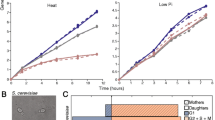Summary
As is expected, a fast growing mutant on casein medium produced larger amount of protease than its parent or sister cultures. As a rule, the mutant yielded protease in a later stage of growth in contrast to its sister strain which produced it at an earlier stage. The heterocaryon between slow growing strains produced protease early as well as late, and the activity increased far beyond the productions limit of each component strain. Upon measuring the nuclear ratios during cultivation, the effect was considered to be due to heterocaryotic vigor or a kind of heterosis. The heterozygous diploid between slow growers also yielded protease as well as the heterocaryon. When fast grower and slow grower were paired, the resulting diploid showed the highest activity of the enzyme among these strains.
Similar content being viewed by others
Literature
Atwood, K. C., andF. Mukai: Nuclear distribution in conidia ofNeurospora heterocaryons. Genetics40, 438–443 (1955).
Ciegler, A., andK. B. Raper: Application of heterocaryons ofAspergillus to commerical type fermentations. Appl. Microbiol.5, 106–110 (1957).
Hagiwara, B.: Protease, pp. 207–212. Hyojun Seikagaku Jikkenho: Bunkodo Co. Ltd. 1953.
Ikeda, Y.: Genetic background of Kojic acid production studied with metabolic mutants ofAspergillus oryzae. Bull. Agr. Chem. Soc. Japan22, 233–238 (1958).
Ikeda, Y., K. Nakamura, K. Uchida andC. Ishitani: Two attemps upon improving an industrial strain ofAspergillus oryzae through somatic recombination and polyploidation. J. Gen. and Appl. Microbiol.3, 93–101 (1957).
Kiritani, K.: Selection of fitter type nuclei in heterocaryons ofAspergillus oryzae. Z. f. Vererb.-Lehre90, 182–189 (1959).
Motonaga, K., andY. Miura: Protease production by a submerged culture ofAspergillus oryzae. Part I. Selection of strain and medium suitable for producing protease active in neutral and alkaline reaction. [In Japanese.] J. Agr. Chem. Soc. Japan32, 422–426 (1958).
Prout, T., C. Huebschman, H. Levene andF. J. Ryan: The proportions in nuclear types inNeurospora heterocaryons as determined by plating conidia. Genetics38, 518–529 (1953).
Yasui, T.: The effect of Zn on the production of protease inAspergillus oryzae (Speech at the monthly meeting of the Agricult. Chem. Soc. of Japan.) 1956.
Author information
Authors and Affiliations
Additional information
With 4 Figures in the Text
Rights and permissions
About this article
Cite this article
Kiritani, K., Ikeda, Y. Heterosis observed inAspergillus oryzae and its significance in Koji manufacture. Zeitschrift für Vererbungslehre 90, 190–197 (1959). https://doi.org/10.1007/BF00888751
Received:
Issue Date:
DOI: https://doi.org/10.1007/BF00888751




